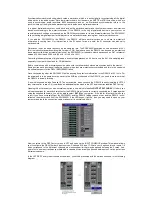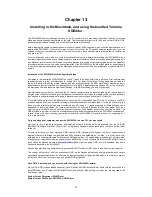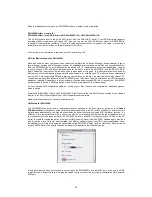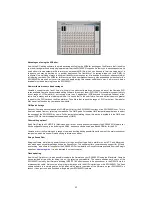
49
Make sure when you go to play back you new track that the old one without effects is muted, and also make sure that
the effects settings you have just applied are no longer still active in the XGEditor mixer window. As you will (if you
are playing the audio track out of the same wave port) just end up adding the effects again to the track being played
back, which will sound very odd.
Make sure also that you correctly set up the panning for the playback track with your new effects added, so that any
stereo effects such as delay LCR sound right. Also try to make sure your volume levels are up to maximum, as the
loopback record option can attenuate the gain of the original track (this is to compensate for EQ and effects
processing which can add up to 6dB of gain) by as much as 6dB.
How do I add effects to an audio track then?
From what you have learned so far, you can see that inside XGWorks or XGEdit’s analogue mixer you have effects
send dials for the Chorus, Reverb and Variation effects busses. These allow you to easily apply effects to either pre
recorded audio tracks on playback or to the analogue inputs themselves for effects monitoring or recording live. If you
are adding a variation effect the only golden rule is
PUT THE VARIATION CONNECTION TO SYS MODE
which can
be done easily in XGEDIT or XGWorks. For insertion effects, XGEdit is easier in that the small led indicators at the
top marked I1, I2 and P (P only works if you have an effects based PLG board such as the PLG100-VH installed) can
easily just be clicked to add an insert effect to any audio part. They light up green when applied.
This is covered in more detail in the XGEdit help file that accompanies XGEdit.
What about EQ on audio parts?
Unlike our DS2416 sister card (covered in more detail in the next chapter) the SW1000XG doesn’t have dedicated
EQ for each audio part. The Multi band parametric EQ master will affect audio and MIDI (as this is the final stage
before the audio actually goes out), but the 2 band EQ which can be applied to MIDI parts cannot be applied to audio
parts. So how do we add EQ to individual audio sections? Simple, we use the
Insert
effects and
Variation
effects
buss with programs like ‘3 band parametric eq’. You will notice from the list of effects available in the SW1000XG
manual that you have options for 3-band fully parametric eq and 2 band eq. Using the methods we have just
discussed for adding effects to audio parts, you can easily apply all 3 effects busses that may act as eq (VAR, INS1,
INS2) to audio parts. You may then loopback re-record them so that the eq is committed to a part. Don’t erase the
pre-eq audio track, just mute it, as you may wish to change the eq settings when you go to final mix. As you will see
in the next chapter, the eq is one of the DS2416 cards strongest points, although as you will also see, it is more
limited in overall effects bussing, and has no MIDI or synth section. This is why the 2-card combination is such a
strong one.
So in summary
SW1000#1 Wave record allows you to monitor effects but records dry to your hard drive
SW1000#2 Wave record will record with any effects you have set up on audio parts, and also is the loopback record
buss so you can add effects at a later date to audio tracks
The SW1000XG has 6 stereo outputs (virtual) that can play back as many hard disk tracks in your audio sequencer
as your hard drive and PC will allow. It is not limited to only 12-track playback.
The SW1000XG audio playback mixer can be hardware controlled from any MIDI controller device
All SW1000XG audio mixing, panning and effects functions can be controlled via MIDI sysex excepting input gain
level, which is non-controllable unless using SW1000#2 wave record.
Common pitfalls
Due to the lack of MME input gain, many people find that the Windows mixer input control is greyed out, and thus
think that they cannot control the level of signal getting into the SW1000XG. This as we have shown is not always the
case although Yamaha do recommend an external mixer for controlling the level going into the SW1000XG. The
other common mistake that people make is that when they go to playback their ‘loopback’ audio track, it sounds
muffled, this is almost always down to incorrect panning settings in the wave output port being used. Run up XGEdit
and set the pan position to full left and right, and make sure the volume level is set to maximum for the wave port you
intend to use. You should also check that you are not adding effects to the already processed track again (unless you
intend to), and that your master 5 band parametric eq settings are not processing the sound again. The standard
Windows MME driver is just one way of controlling the SW1000XG audio in Windows, another is ASIO. We shall
discuss the differences with ASIO drivers in the ASIO and Macintosh sections of this guide.
















































